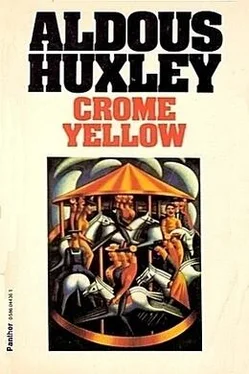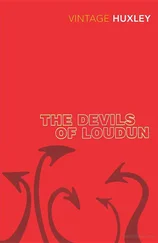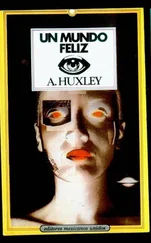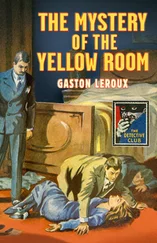Mr. Scogan paused, looked up once more at the towering house, then murmured the word "Eccentricity," two or three times.
"Eccentricity…It's the justification of all aristocracies. It justifies leisured classes and inherited wealth and privilege and endowments and all the other injustices of that sort. If you're to do anything reasonable in this world, you must have a class of people who are secure, safe from public opinion, safe from poverty, leisured, not compelled to waste their time in the imbecile routines that go by the name of Honest Work. You must have a class of which the members can think and, within the obvious limits, do what they please. You must have a class in which people who have eccentricities can indulge them and in which eccentricity in general will be tolerated and understood. That's the important thing about an aristocracy. Not only is it eccentric itself—often grandiosely so; it also tolerates and even encourages eccentricity in others. The eccentricities of the artist and the new–fangled thinker don't inspire it with that fear, loathing, and disgust which the burgesses instinctively feel towards them. It is a sort of Red Indian Reservation planted in the midst of a vast horde of Poor Whites—colonials at that. Within its boundaries wild men disport themselves—often, it must be admitted, a little grossly, a little too flamboyantly; and when kindred spirits are born outside the pale it offers them some sort of refuge from the hatred which the Poor Whites, en bons bourgeois, lavish on anything that is wild or out of the ordinary. After the social revolution there will be no Reservations; the Redskins will be drowned in the great sea of Poor Whites. What then? Will they suffer you to go on writing villanelles, my good Denis? Will you, unhappy Henry, be allowed to live in this house of the splendid privies, to continue your quiet delving in the mines of futile knowledge? Will Anne…"
"And you," said Anne, interrupting him, "will you be allowed to go on talking?"
"You may rest assured," Mr. Scogan replied, "that I shall not. I shall have some Honest Work to do."
"Blight, Mildew, and Smut…" Mary was puzzled and distressed. Perhaps her ears had played her false. Perhaps what he had really said was, "Squire, Binyon, and Shanks," or "Childe, Blunden, and Earp," or even "Abercrombie, Drinkwater, and Rabindranath Tagore." Perhaps. But then her ears never did play her false. "Blight, Mildew, and Smut." The impression was distinct and ineffaceable. "Blight, Mildew…" she was forced to the conclusion, reluctantly, that Denis had indeed pronounced those improbable words. He had deliberately repelled her attempts to open a serious discussion. That was horrible. A man who would not talk seriously to a woman just because she was a woman—oh, impossible! Egeria or nothing. Perhaps Gombauld would be more satisfactory. True, his meridional heredity was a little disquieting; but at least he was a serious worker, and it was with his work that she would associate herself. And Denis? After all, what WAS Denis? A dilettante, an amateur…
Gombauld had annexed for his painting–room a little disused granary that stood by itself in a green close beyond the farm–yard. It was a square brick building with a peaked roof and little windows set high up in each of its walls. A ladder of four rungs led up to the door; for the granary was perched above the ground, and out of reach of the rats, on four massive toadstools of grey stone. Within, there lingered a faint smell of dust and cobwebs; and the narrow shaft of sunlight that came slanting in at every hour of the day through one of the little windows was always alive with silvery motes. Here Gombauld worked, with a kind of concentrated ferocity, during six or seven hours of each day. He was pursuing something new, something terrific, if only he could catch it.
During the last eight years, nearly half of which had been spent in the process of winning the war, he had worked his way industriously through cubism. Now he had come out on the other side. He had begun by painting a formalised nature; then, little by little, he had risen from nature into the world of pure form, till in the end he was painting nothing but his own thoughts, externalised in the abstract geometrical forms of the mind's devising. He found the process arduous and exhilarating. And then, quite suddenly, he grew dissatisfied; he felt himself cramped and confined within intolerably narrow limitations. He was humiliated to find how few and crude and uninteresting were the forms he could invent; the inventions of nature were without number, inconceivably subtle and elaborate. He had done with cubism. He was out on the other side. But the cubist discipline preserved him from falling into excesses of nature worship. He took from nature its rich, subtle, elaborate forms, but his aim was always to work them into a whole that should have the thrilling simplicity and formality of an idea; to combine prodigious realism with prodigious simplification. Memories of Caravaggio's portentous achievements haunted him. Forms of a breathing, living reality emerged from darkness, built themselves up into compositions as luminously simple and single as a mathematical idea. He thought of the "Call of Matthew," of "Peter Crucified," of the "Lute players," of "Magdalen." He had the secret, that astonishing ruffian, he had the secret! And now Gombauld was after it, in hot pursuit. Yes, it would be something terrific, if only he could catch it.
For a long time an idea had been stirring and spreading, yeastily, in his mind. He had made a portfolio full of studies, he had drawn a cartoon; and now the idea was taking shape on canvas. A man fallen from a horse. The huge animal, a gaunt white cart–horse, filled the upper half of the picture with its great body. Its head, lowered towards the ground, was in shadow; the immense bony body was what arrested the eye, the body and the legs, which came down on either side of the picture like the pillars of an arch. On the ground, between the legs of the towering beast, lay the foreshortened figure of a man, the head in the extreme foreground, the arms flung wide to right and left. A white, relentless light poured down from a point in the right foreground. The beast, the fallen man, were sharply illuminated; round them, beyond and behind them, was the night. They were alone in the darkness, a universe in themselves. The horse's body filled the upper part of the picture; the legs, the great hoofs, frozen to stillness in the midst of their trampling, limited it on either side. And beneath lay the man, his foreshortened face at the focal point in the centre, his arms outstretched towards the sides of the picture. Under the arch of the horse's belly, between his legs, the eye looked through into an intense darkness; below, the space was closed in by the figure of the prostrate man. A central gulf of darkness surrounded by luminous forms…
The picture was more than half finished. Gombauld had been at work all the morning on the figure of the man, and now he was taking a rest—the time to smoke a cigarette. Tilting back his chair till it touched the wall, he looked thoughtfully at his canvas. He was pleased, and at the same time he was desolated. In itself, the thing was good; he knew it. But that something he was after, that something that would be so terrific if only he could catch it—had he caught it? Would he ever catch it?
Three little taps—rat, tat, tat! Surprised, Gombauld turned his eyes towards the door. Nobody ever disturbed him while he was at work; it was one of the unwritten laws. "Come in!" he called. The door, which was ajar, swung open, revealing, from the waist upwards, the form of Mary. She had only dared to mount half–way up the ladder. If he didn't want her, retreat would be easier and more dignified than if she climbed to the top.
Читать дальше











